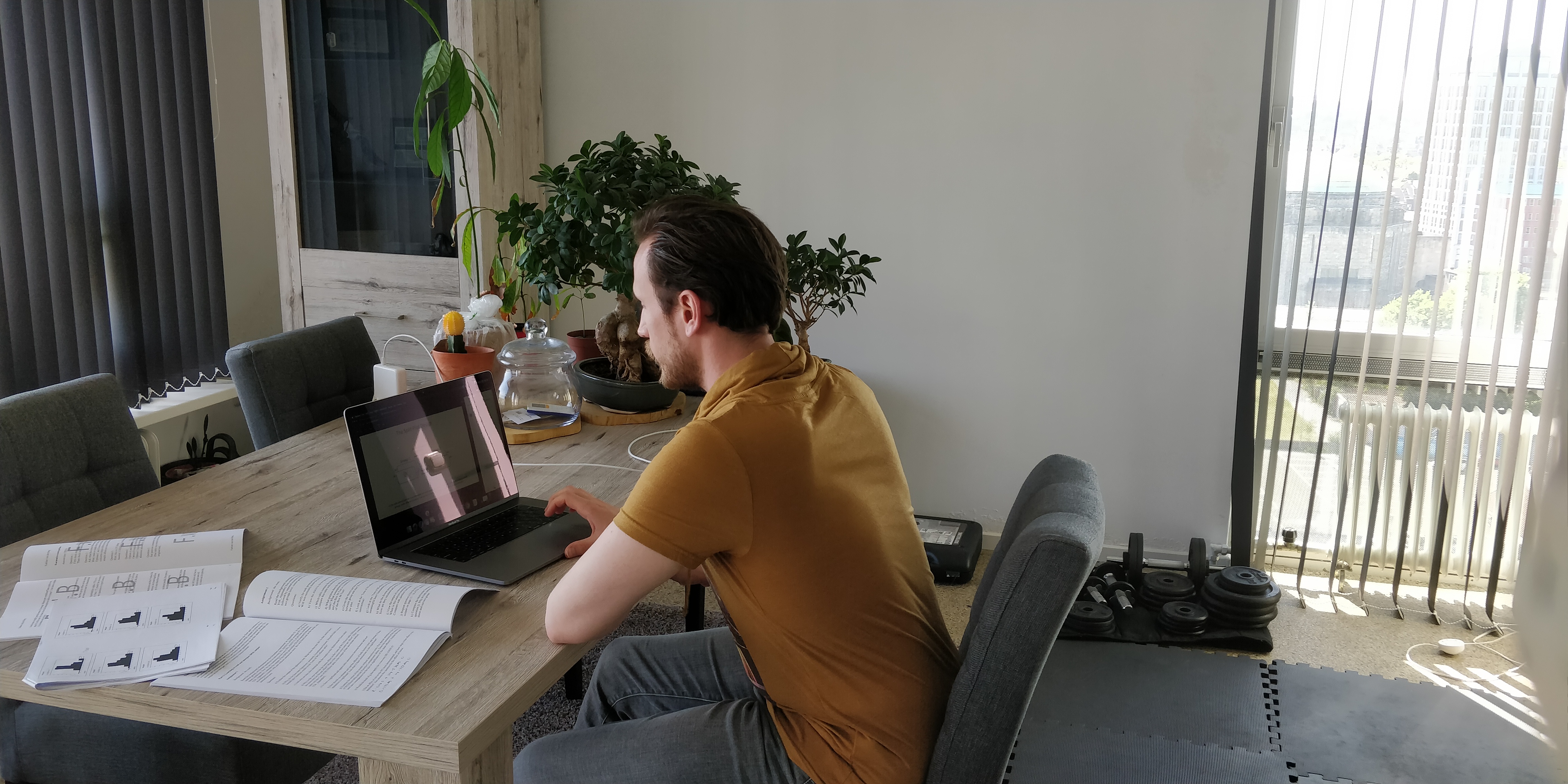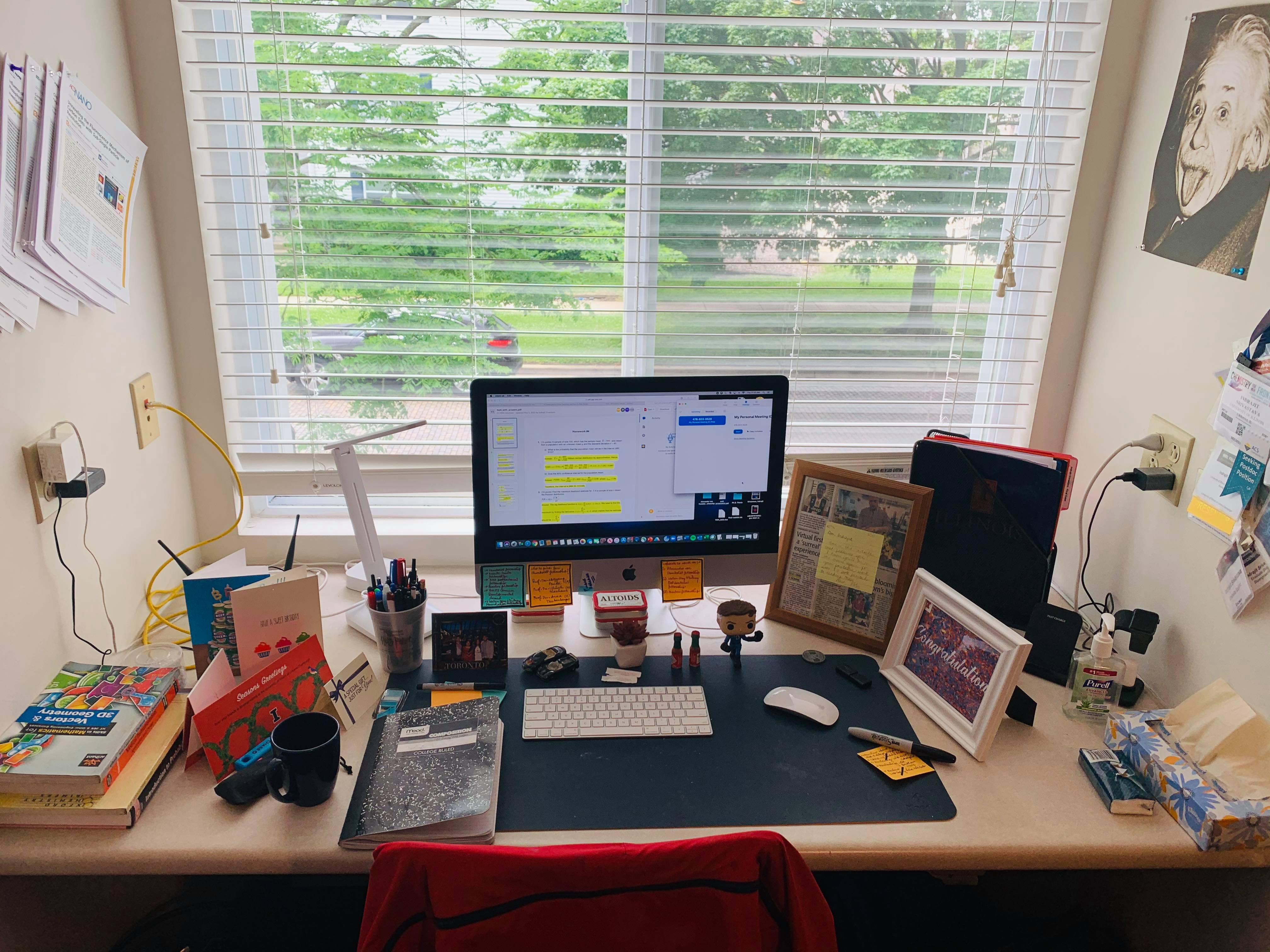Teaching during COVID-19: 4 Researchers share their experiences

Fabian Berg, Shaun Boustani, Hayley Cullen, and Indrajit Srivastava are researchers from the varied fields of cognitive science, education, psychology and bio-engineering, respectively, but they have one thing in common—they are deeply invested in teaching. For many PhDs, this is an inevitable part of their workload and it’s not surprising that not everyone enjoys it. Not all researchers enjoy teaching, let alone feel comfortable with the responsibility that comes with that duty.
When universities went on lockdown because of the COVID-19 pandemic, researchers had to pivot quickly and balance their workload; those teaching had the additional work of providing support to their students. Could they do this successfully? Did they themselves feel supported? These questions made me reach out to Fabian, Shaun, Hayley, and Indrajit to learn more about how they were managing their pedagogical duties amid the lockdown. Specifically, I asked them to share their thoughts on these questions/aspects of teaching during COVID-19:
- What challenges did you face because of the shift from the physical classroom or a face-to-face mentoring space to a virtual one?
- Would you say you have adequate support as an instructor/mentor? What kind of support do you wish you had?
- What would you say has helped you with this transition?
- Does anything stand out from your experiences during this time—any memorable anecdote or story that you’d like to share?
Read on to find out what teaching in the midst of a pandemic has been like for these researchers!
PhD, Developmental Cognitive Neuroscience, Maastricht University, The Netherlands

The challenges I faced
The biggest challenge for me was to figure out how to explain fairly difficult concepts without the use of a whiteboard. It’s very convenient being able to draw things on a board, sketch out examples, add numbers or arrows where needed. Yes, it’s possible to use to digital whiteboard, but that doesn’t quite work the same using a mouse. I solved this by anticipating the difficult parts. It’s not the first time giving this course, been teaching this exact course for years, so I know what students find difficult. I used my experience and whipped up slides for each week, expanding and explaining what I knew would be difficult. I even made graphs, charts, and images to illustrate the various points I knew would be important for that week and the weeks to come.
I also shared these slides with the other tutors. A lot of them were 3rd year students who followed this course last year. Explaining statistics is difficult enough, managing a group of students and doing that online makes it even harder. I figured my slides might provide some structure and give them more time to prepare. They, and the course coordinator, were very grateful so that turned out wonderful.
The second challenge was the online setting. I was very used to observing students, watch their face and body language to gauge their understanding. If a topic is too confusing, you can tell by their face! Having everything online messed that up big time, I couldn’t see if everyone was following my explanations.
There were ways to solve this, the obvious one being webcams on. Many other tutors did this, but I chose not to make video mandatory. Not everyone was comfortable with it and even with just audio I sometimes lost people due to a bad connection. I chose to ask, and ask A LOT, if everyone was still following, if it made sense, and simply create an environment where they felt safe to say, “I don’t get it”.
I think it worked, the students were honest and often said they would like me to explain things again. I also said I was ok with them using the chat instead, lowering the bar for engagement even more.
The support I had
I think so, not so much from the university in general but more so from the course coordinator. We had a weekly meeting where every tutor could ask questions, discuss problems, and just say how things were going. We could also always e-mail the coordinator with any questions we had and he would answer the same day.
He was also aware how strange the situation was and that this wasn’t necessarily his comfort-zone, so he allowed us a lot of freedom in how we went about our tutorial groups. Some people used Blackboard, others switched to Zoom.
What helped with the transition
The best help in transitioning from regular to online teaching was time. Having to make the slides in advance took time and effort and I was fortunate to have just enough time to make the materials I needed.
Normally I would simply draw things on the board and read my own material that I’ve written over the years. However, the whole online setting required more preparation, the kind that I know not many people have the time to do.
It’s also not the kind of job others can do, explanations have to be simple yet precise. The other tutors did offer to help out, but the course coordinator and I agreed it would be better if I made the slides and he gave feedback on them before sending it to everyone.
What this experience made me realize
The most memorable thing from this entire situation would be the students themselves. Because everything was online, the meetings were not mandatory, they didn’t have to log in and join.

Fabian prepping before one of his classes
Nevertheless, they did. I had most of the students assigned to my group present for every meeting. They weren’t passively listening to me explaining things either; they engaged, answered my questions, and even asked their own. They were actively participating despite being at home during a pandemic. I was amazed at how well they did, how quickly they picked up the material, and I am just proud of how they handled the situation. It’s not just strange for us to teach, it’s also strange for them to be learning amid all this.
PhD candidate, Education and Cognition, University of Sydney, Australia

The challenges I faced
The initial transition was very difficult. Working from home and teaching from home is definitely a compromise. More than once a family member would walk past “the office” and scream, or sing, or burp! But after a few weeks I think the students, my family, (and me!) adjusted to a new normal. I think it's the fact that we are sharing the difficulty, we're all dealing with distractions and an imperfect scenario.
Another thing was that due to campus shutdown we had to use Zoom for classes. That meant learning how to use the software, making sure it was reliable, and then teaching other tutors how to use it. A simple thing which was surprisingly difficult was time management between classes. In physical classrooms there's always a ten minute break from the end of one class to the beginning of the next. Online, classes tended to blend into one another, leaving very little time for a break, and that gets exhausting.
The support I had
Yeah! I have more than adequate support actually. We had a team of really capable individuals in administration who helped a lot with the transition to Zoom. They gave us a lot of materials—both written and recorded which showed us different ways of running a tutorial and really did help us with understanding the software. The university also supported us buying and moving office supplies as needed, making sure that we could have functional webcams and other gear to run our tutorials from home. One thing that I wish we had more time with was the transition. There are so many opportunities afforded by online teaching that I think we weren't able to capitalize on because of time pressures, but I'm sure we'll be in a better place come next semester.
What helped with the transition
The single biggest help in this transition was our students. We always knew that our students were smart and capable, but this semester they proved to be extraordinarily resilient and determined. After some initial issues with Zoom and doubts about whether students would be able to keep up with the online transition, attendance remained remarkably high. Those who were attending were also very engaged and really just wanted to learn. For all the difficulties in this teaching transition, I'm incredibly proud and impressed by our students, and that has helped maintain motivation.
What this experience made me realize
The most significant observation for me was that it was still possible to form a strong student-teacher bond online. I've had doubts about online teaching, it feels like it might have been remote and detached, but over the last 12 weeks it feels like I've learnt a lot about my students, about the things they're dealing with, things they like and don't like.
The most memorable experiences came from our student webinars. Each week my supervisor and I held two webinars where students could ask questions in real time, which we would answer. A lot of the questions were about course content and admin, but in every webinar students joked and teased us about our preferences, asked us about our favorite books, movies, podcasts and video-games, etc., and really appreciated the support. It was a reminder that teaching and engagement are bi-directional; students are more engaged when they feel they are being engaged with.

Shaun and his supervisor Dr. Caleb Owens waving goodbye at the end of one of their webinars
Something else that has stood out is also this feeling that we could always be doing more. We've always cared about student well-being and development, but I think this semester it's really come to the foreground. These guys are going through a lot and we need to give them more than just academic support. A student of mine was attending a 10 am class but was faced with the choice to either be stuck in Australia for an undefined period, or go back home to South Africa. He chose to go back home, but that meant that the class would happen at 2 am his time and he just couldn't maintain attendance. It's these types of decisions which are not typical, and do make me a little sad. A lot of university education goes beyond academic performance—it's joining communities, making new friends, hopefully becoming a better person. A lot of these experiences are not reproducible online, and so I am hopeful that we can return to campus soon.
PhD candidate, Forensic Psychology, University of Sydney, Australia

The challenges I faced
The change from face-to-face teaching to virtual teaching was a difficult one, and at our institution, it was quite quick. One week we were teaching in a classroom, the next week we were online. My teaching style is very student-driven; I adjust how I teach and the pace I teach at based on what I see in the classroom and the reactions I get from students. So, without having that direct contact, I found it very challenging to determine how much of what I was teaching was being absorbed by students. I had to adapt to checking in with students verbally rather than relying on body language or facial expressions. One further thing I've noticed (that I did not expect) is that online teaching involves a lot of multitasking, and is actually very tiring! You have to keep on top of technical issues while teaching, teaching students, helping students with their own technical issues, checking the chat for any questions, etc. The final challenge I faced was connecting with students. Not having all students on video meant that as a teacher, I felt less connected to students than I would have liked. Needing to get students to mute and unmute themselves to answer questions meant that many of those subtle forms of communication that are important for teaching and establishing rapport were lost.
The support I had
I think I am one of the lucky ones. The coordinator of the course I was teaching was incredible. He put so much time into assisting students, but also into assisting his teachers. He supported every one of his teachers through the whole transition and was always available to answer questions and help troubleshoot any technical difficulties. Honestly, I could not have asked for more support.
What helped with the transition
Compassion and patience were what helped me through this experience of teaching online during COVID-19. It was no doubt a difficult transition for me as a teacher, but I always had in the back of my mind: If it's difficult for me, it's even more difficult for the students. I went into each class with an attitude to be patient, to be kind, and to give students everything I could in that hour a week we had together. That mindset really helped me get through teaching online and actually helped me to genuinely enjoy the experience, so that my students could (hopefully) also enjoy it.
What this experience made me realize

One of the virtual backgrounds Hayley uses – an aerial view of the Sydney Royal Opera House and the Sydney Harbor Bridge
One thing I did with students in the final weeks of teaching was to get each of my students to talk about something fun they had done over the week at the start of class. It was so lovely to start a class by getting to know the students better, and keeping their spirits high by focusing on the positive things in life (and finding common interests). It was also a great ice-breaker and led to some great discussions throughout the class. Each week I would also try to keep things fresh by having a different virtual background (often a city or place in the world - see my attached teaching photo, the Sydney one). There was often a story behind each one which I would share with students so they could learn a bit about me too.
PhD, Department of Bioengineering, The Grainger College of Engineering, University of Illinois at Urbana-Champaign (UIUC)

The challenges I faced
I was most concerned about whether my students had reliable access to the required technological tools. For some of them, a weak internet connection or no internet connection was a major issue—few of the students had connectivity issues during the first live lecture tutorial so we decided to pre-record the lecture materials in advance and upload them to Box (file sharing service) before every week’s lecture. I started sending them an email, each week, in advance about how the course lecture would be carried out so that they knew what would be covered during the Zoom lectures. This way, they could download the lecture and go over it anytime in the week at their convenience.
Before the pandemic, I had to conduct office hours every week as a teaching assistant. Students would come with their queries about the course lecture materials or homework problems. I also conducted review sessions for the midterm before the COVID-19 pandemic. Moving the office hours online was a bit challenging, trying to find a time which suited everybody. However, I encouraged my students to send me emails with their queries about the lecture materials, homework problems, etc. and I tried to get back to them within the same day with answers and useful supplemental reading materials. Considering the awkward circumstances of the pandemic, I feel the time carried out to responds to student’s queries should be considered teaching; it gives you a wonderful opportunity to connect to your students. This could otherwise be something that might be hard to do in a virtual classroom.
The support I had
Grainger College of Engineering at University of Illinois at Urbana-Champaign is one of the topmost engineering schools of the country and was proactive about making the transition from classroom to virtual teaching smooth for both students and instructors/mentors. They gave us useful resources including unlimited access to Zoom (video and tele-conferencing tool) and Box (file sharing service). Also the IT support, UIUC were instrumental in helping us with the transition and helping the students with issues like Matlab access from university server. Finally, the university based Computer-Based-Testing Facility (CBTF) were also very helpful in providing their expertise to conduct an online final exam for the students.
What helped with the transition
I am so glad that we live in an era where technological solutions can be helped to mitigate the effects of the pandemic. However, just posting videos online or conducting review sessions on Zoom are not the ultimate solution. Moving forward, we would need a proper balance between these and how they can complement student’s learning rather than overcomplicating things that leads them losing their motivation.
Also, it is important that as an instructor/mentor, you are proactive and energetic throughout the duration of the online course. You should try to understand student’s situation of carrying out online classes in the pandemic and laying out your expectations (shouldn’t be sky high due to unusual circumstances of the pandemic!) from them are important pointers. Some examples to keep them motivated are: being proactive and posting weekly announcements with clarity, responding to student’s questions via email and grading and returning their homework’s and finals in a timely fashion.
What this experience made me realize
Every year, when I see positive feedback from the students on their teacher evaluation forms, I am overjoyed and flattered. This year with the pandemic and moving the classes to an online environment, seeing their positive comments made me even more ecstatic. I still keep the students feedback forms for every course I have taught as they keep me motivated and excited to teach more. I realized during my PhD that I am absolutely devoted to mentoring and teaching, and I’m hoping to build up on that in a few years once I begin my independent career as a tenure-track faculty at a large research institution.

Indrajit’s teaching space
It gave me a lot of hope talking to these researchers—in one of the most challenging times that academia has faced, it is beautiful to see researchers helping each other and taking on their responsibilities, toward their research and their students, with equal enthusiasm and motivation. Listening to them highlighted yet again that teaching is not just about imparting knowledge but also about supporting each other, adapting, and growing together.
Comments
You're looking to give wings to your academic career and publication journey. We like that!
Why don't we give you complete access! Create a free account and get unlimited access to all resources & a vibrant researcher community.














